Stewart J. Calculus
Подождите немного. Документ загружается.

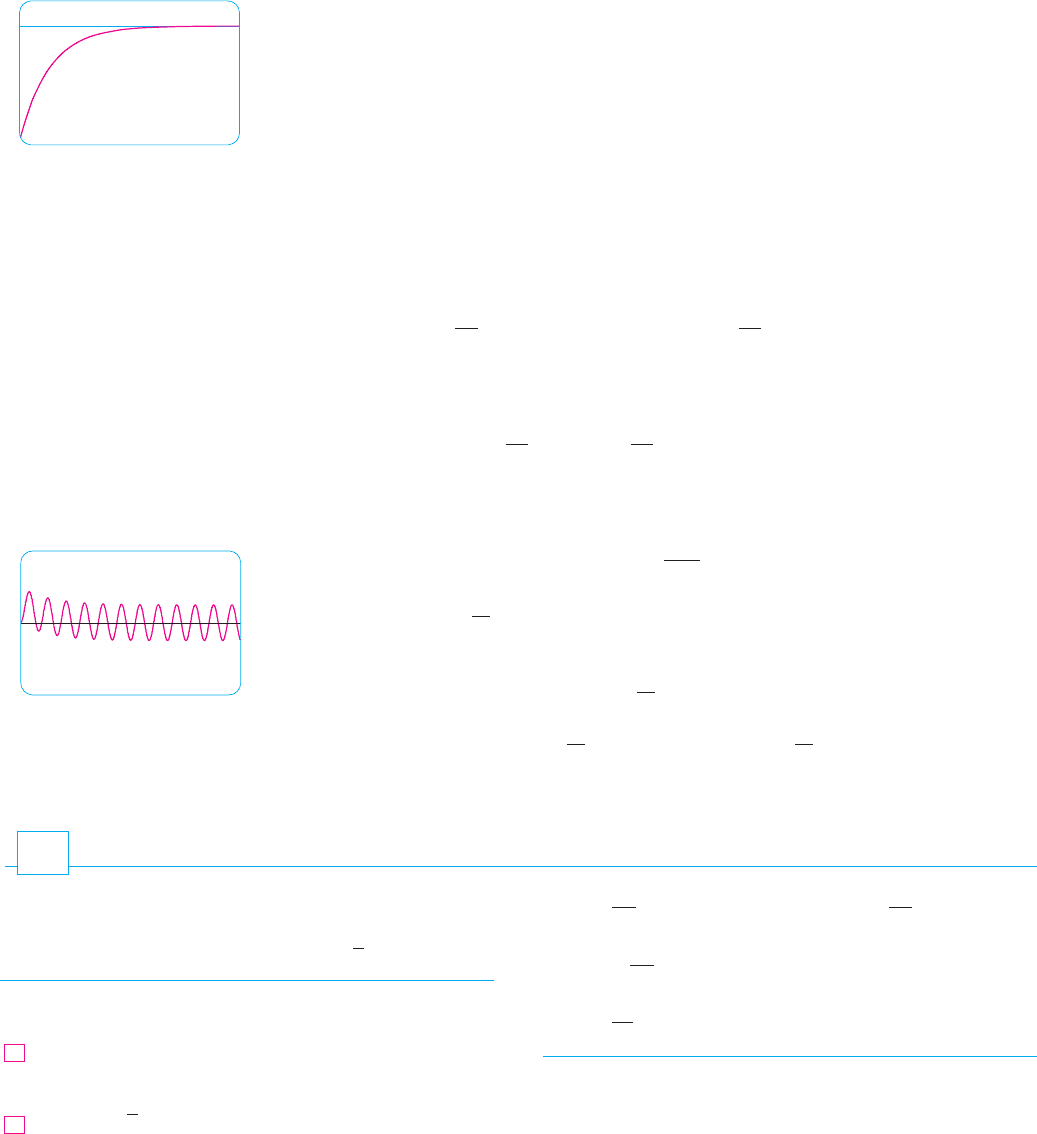
Since , we have , so and
(b) After 1 second the current is
(c) The limiting value of the current is given by
M
EXAMPLE 5 Suppose that the resistance and inductance remain as in Example 4
but, instead of the battery, we use a generator that produces a variable voltage of
volts. Find .
SOLUTION This time the differential equation becomes
The same integrating factor gives
Using Formula 98 in the Table of Integrals, we have
Since , we get
so M
I!t" !
5
101
!sin 30t ! 10 cos 30t" "
50
101
e
!3t
!
50
101
" C ! 0
I!0" ! 0
I !
5
101
!sin 30t ! 10 cos 30t" " Ce
!3t
e
3t
I !
y
15e
3t
sin 30t dt ! 15
e
3t
909
!3 sin 30t ! 30 cos 30t" " C
d
dt
!e
3t
I" ! e
3t
dI
dt
" 3e
3t
I ! 15e
3t
sin 30t
e
3t
dI
dt
" 3I ! 15 sin 30tor4
dI
dt
" 12I ! 60 sin 30t
I!t"E!t" ! 60 sin 30t
! 5 ! 0 ! 5! 5 ! 5 lim
t
l
#
e
!3t
lim
t l #
I!t" ! lim
t l #
5!1 ! e
!3t
"
I!1" ! 5!1 ! e
!3
" # 4.75 A
I!t" ! 5!1 ! e
!3t
"
C ! !55 " C ! 0I!0" ! 0
642
|| ||
CHAPTER 10 DIFFERENTIAL EQUATIONS
F I G U R E 5
6
0
2.5
y=5
N Figure 5 shows how the current in Example 4
approaches its limiting value.
N Figure 6 shows the graph of the current
when the battery is replaced by a generator.
F I G U R E 6
2
_2
2.50
11. 12.
13.
,
14.
15–20 Solve the initial-value problem.
15. , y!0" ! 2y$ ! x " y
t ln t
dr
dt
" r ! te
t
t % 0!1 " t"
du
dt
" u ! 1 " t
x
dy
dx
! 4y ! x
4
e
x
sin x
dy
dx
" !cos x"y ! sin!x
2
"
1– 4 Determine whether the differential equation is linear.
1. 2.
3. 4.
5–14 Solve the differential equation.
6.
7. 8.
10.
y$ " y ! sin!e
x
"xy$ " y !
s
x
9.
x
2
y$ " 2xy ! cos
2
xxy$ ! 2y ! x
2
y$ ! x " 5yy$ " 2y ! 2e
x
5.
xy "
s
x
! e
x
y$yy$ " xy ! x
2
y$ " cos y ! tan xy$ " cos x ! y
E X E R C I S E S
10.5

this case Kirchhoff’s Law gives
But (see Example 3 in Section 3.7), so we have
Suppose the resistance is , the capacitance is F, a
battery gives a constant voltage of 60 V, and the initial charge
is C. Find the charge and the current at time .
30. In the circuit of Exercise 29, , , ,
and . Find the charge and the current at time .
Let be the performance level of someone learning a skill
as a function of the training time . The graph of is called a
learning curve. In Exercise 13 in Section 10.1 we proposed
the differential equation
as a reasonable model for learning, where is a positive con-
stant. Solve it as a linear differential equation and use your
solution to graph the learning curve.
32. Two new workers were hired for an assembly line. Jim pro-
cessed 25 units during the first hour and 45 units during the
second hour. Mark processed 35 units during the first hour
and 50 units the second hour. Using the model of Exercise 31
and assuming that , estimate the maximum number
of units per hour that each worker is capable of processing.
In Section 10.3 we looked at mixing problems in which the
volume of fluid remained constant and saw that such prob-
lems give rise to separable equations. (See Example 6 in that
section.) If the rates of flow into and out of the system are
different, then the volume is not constant and the resulting
differential equation is linear but not separable.
A tank contains 100 L of water. A solution with a salt con-
centration of is added at a rate of . The
solution is kept mixed and is drained from the tank at a rate
of . If is the amount of salt (in kilograms) after
minutes, show that satisfies the differential equation
Solve this equation and find the concentration after
20 minutes.
34. A tank with a capacity of 400 L is full of a mixture of water
and chlorine with a concentration of 0.05 g of chlorine per
dy
dt
! 2 !
3y
100 " 2t
yt
y!t"3 L$min
5 L$min0.4 kg$L
33.
P!0" ! 0
k
dP
dt
! k%M ! P!t"&
Pt
P!t"
31.
tE!t" ! 10 sin 60t
Q!0" ! 0C ! 0.01 FR ! 2 &
C
E
R
tQ!0" ! 0
0.055 &
R
dQ
dt
"
1
C
Q ! E!t"
I ! dQ$dt
RI "
Q
C
! E!t"
16. , ,
17. ,
18. , ,
,
20. ,
;
21–22 Solve the differential equation and use a graphing cal-
culator or computer to graph several members of the family of
solutions. How does the solution curve change as varies?
21. 22.
23. A Bernoulli differential equation (named after James
Bernoulli) is of the form
Observe that, if or , the Bernoulli equation is linear.
For other values of , show that the substitution
transforms the Bernoulli equation into the linear equation
24 –25 Use the method of Exercise 23 to solve the differential
equation.
24.
26. Solve the second-order equation by
making the substitution .
27. In the circuit shown in Figure 4, a battery supplies a constant
voltage of 40 V, the inductance is 2 H, the resistance is ,
and .
(a) Find .
(b) Find the current after s.
28. In the circuit shown in Figure 4, a generator supplies a volt-
age of volts, the inductance is H, the
resistance is , and A.
(a) Find .
(b) Find the current after s.
;
(c) Use a graphing device to draw the graph of the current
function.
29. The figure shows a circuit containing an electromotive force,
a capacitor with a capacitance of farads (F), and a resistor
with a resistance of ohms ( ). The voltage drop across the
capacitor is , where is the charge (in coulombs), so in QQ$C
&R
C
0.1
I!t"
I!0" ! 120 &
1E!t" ! 40 sin 60t
0.1
I!t"
I!0" ! 0
10 &
u ! y$
xy' " 2y$ ! 12x
2
y$ "
2
x
y !
y
3
x
2
25.
xy$ " y ! !xy
2
du
dx
" !1 ! n" P!x"u ! !1 ! n"Q!x"
u ! y
1!n
n
1n ! 0
dy
dx
" P!x"y ! Q!x"y
n
y$ " !cos x"y ! cos xxy$ " 2y ! e
x
C
y!0" ! 2!x
2
" 1"
dy
dx
" 3x!y ! 1" ! 0
y!
(
" ! 0xy$ ! y " x
2
sin x
19.
y!4" ! 20x % 02xy$ " y ! 6x
v!0" ! 5
dv
dt
! 2t
v ! 3t
2
e
t
2
y!1" ! 0t % 0t
dy
dt
" 2y ! t
3
SECTION 10.5 LINEAR EQUATIONS
|| ||
643
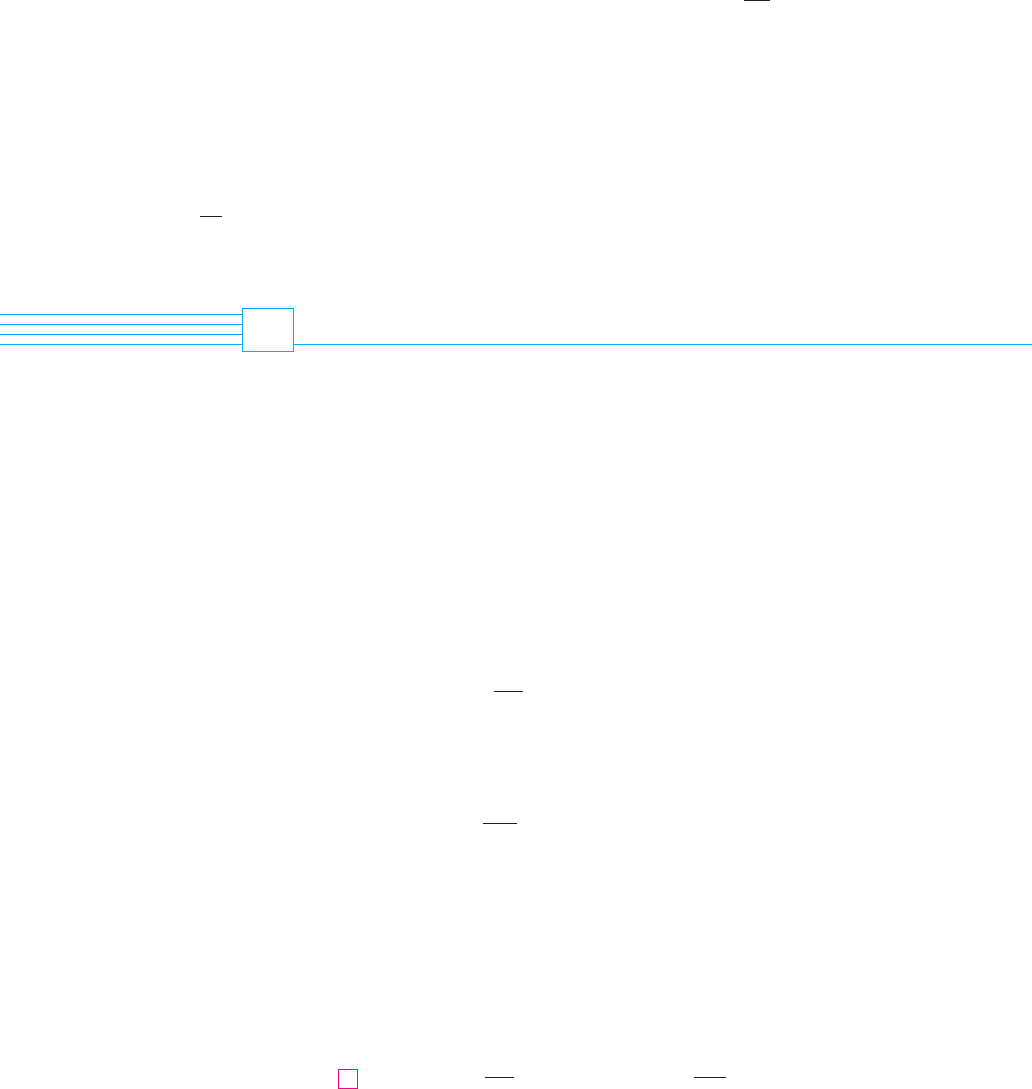
(a) Solve this as a linear equation to show that
(b) What is the limiting velocity?
(c) Find the distance the object has fallen after seconds.
36. If we ignore air resistance, we can conclude that heavier
objects fall no faster than lighter objects. But if we take air
resistance into account, our conclusion changes. Use the
expression for the velocity of a falling object in Exercise 35(a)
to find and show that heavier objects do fall faster than
lighter ones.
d
v$dm
t
v !
mt
c
!1 ! e
!ct$m
"
liter. In order to reduce the concentration of chlorine, fresh
water is pumped into the tank at a rate of . The mixture is
kept stirred and is pumped out at a rate of . Find the
amount of chlorine in the tank as a function of time.
35. An object with mass is dropped from rest and we assume
that the air resistance is proportional to the speed of the object.
If is the distance dropped after seconds, then the speed is
and the acceleration is . If is the accelera-
tion due to gravity, then the downward force on the object is
, where is a positive constant, and Newton’s Second
Law gives
m
d
v
dt
! mt ! cv
cmt ! cv
ta ! v$!t"v ! s$!t"
ts!t"
m
10 L$s
4 L$s
644
|| ||
CHAPTER 10 DIFFERENTIAL EQUATIONS
PREDATOR-PREY SYSTEMS
We have looked at a variety of models for the growth of a single species that lives alone in
an environment. In this section we consider more realistic models that take into account
the interaction of two species in the same habitat. We will see that these models take the
form of a pair of linked differential equations.
We first consider the situation in which one species, called the prey, has an ample food
supply and the second species, called the predator, feeds on the prey. Examples of prey and
predators include rabbits and wolves in an isolated forest, food fish and sharks, aphids and
ladybugs, and bacteria and amoebas. Our model will have two dependent variables and
both are functions of time. We let be the number of prey (using R for rabbits) and
be the number of predators (with W for wolves) at time t.
In the absence of predators, the ample food supply would support exponential growth
of the prey, that is,
In the absence of prey, we assume that the predator population would decline at a rate pro-
portional to itself, that is,
With both species present, however, we assume that the principal cause of death among the
prey is being eaten by a predator, and the birth and survival rates of the predators depend
on their available food supply, namely, the prey. We also assume that the two species
encounter each other at a rate that is proportional to both populations and is therefore pro-
portional to the product RW. (The more there are of either population, the more encoun-
ters there are likely to be.) A system of two differential equations that incorporates these
assumptions is as follows:
where k, r, a, and b are positive constants. Notice that the term !aRW decreases the nat-
ural growth rate of the prey and the term bRW increases the natural growth rate of the
predators.
dW
dt
! !rW " bRW
dR
dt
! kR ! aRW
1
where r is a positive constant
dW
dt
! !rW
where k is a positive constant
dR
dt
! kR
W!t"R!t"
10.6
W represents the predator.
R represents the prey.

The equations in (1) are known as the predator-prey equations, or the Lotka-Volterra
equations. A solution of this system of equations is a pair of functions and that
describe the populations of prey and predator as functions of time. Because the system is
coupled (R and W occur in both equations), we can’t solve one equation and then the other;
we have to solve them simultaneously. Unfortunately, it is usually impossible to find
explicit formulas for R and W as functions of t. We can, however, use graphical methods
to analyze the equations.
EXAMPLE 1 Suppose that populations of rabbits and wolves are described by the
Lotka-Volterra equations (1) with , , , and . The
time is measured in months.
(a) Find the constant solutions (called the equilibrium solutions) and interpret
the answer.
(b) Use the system of differential equations to find an expression for .
(c) Draw a direction field for the resulting differential equation in the RW-plane. Then
use that direction field to sketch some solution curves.
(d) Suppose that, at some point in time, there are 1000 rabbits and 40 wolves. Draw the
corresponding solution curve and use it to describe the changes in both population levels.
(e) Use part (d) to make sketches of R and W as functions of t.
SOLUTION
(a) With the given values of k, a, r, and b, the Lotka-Volterra equations become
Both R and W will be constant if both derivatives are 0, that is,
One solution is given by R ! 0 and W ! 0. (This makes sense: If there are no rabbits or
wolves, the populations are certainly not going to increase.) The other constant solution is
So the equilibrium populations consist of 80 wolves and 1000 rabbits. This means that
1000 rabbits are just enough to support a constant wolf population of 80. There are
neither too many wolves (which would result in fewer rabbits) nor too few wolves
(which would result in more rabbits).
(b) We use the Chain Rule to eliminate t :
so
dW
dR
!
dW
dt
dR
dt
!
!0.02W " 0.00002RW
0.08R ! 0.001RW
dW
dt
!
dW
dR
dR
dt
R !
0.02
0.00002
! 1000W !
0.08
0.001
! 80
W$ ! W!!0.02 " 0.00002R" ! 0
R$ ! R!0.08 ! 0.001W" ! 0
dW
dt
! !0.02W " 0.00002RW
dR
dt
! 0.08R ! 0.001RW
dW$dR
t
b ! 0.00002r ! 0.02a ! 0.001k ! 0.08
V
W!t"R!t"
SECTION 10.6 PREDATOR-PREY SYSTEMS
|| ||
645
N The Lotka-Volterra equations were proposed
as a model to explain the variations in the shark
and food-fish populations in the Adriatic Sea
by the Italian mathematician Vito Volterra
(1860–1940).
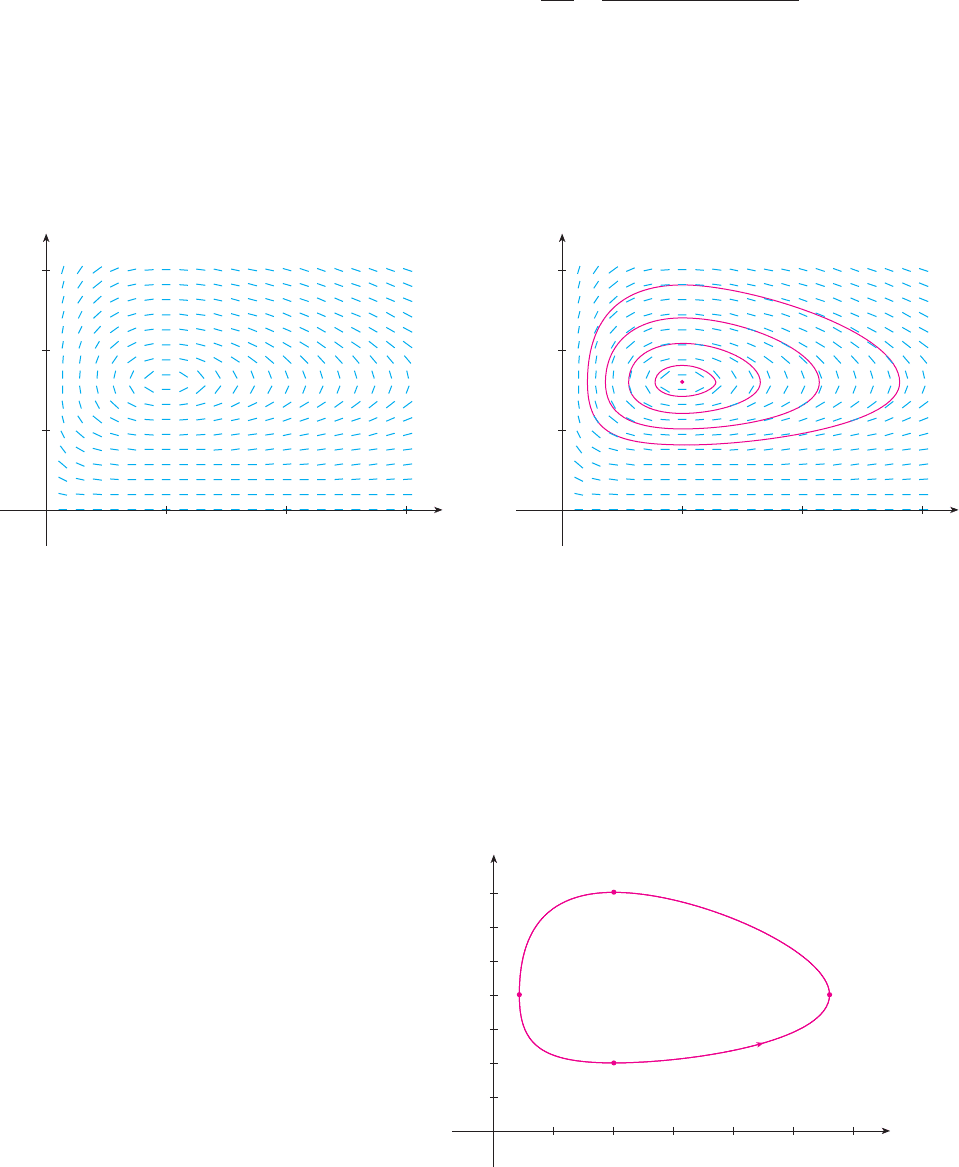
(c) If we think of W as a function of R, we have the differential equation
We draw the direction field for this differential equation in Figure 1 and we use it to
sketch several solution curves in Figure 2. If we move along a solution curve, we
observe how the relationship between R and W changes as time passes. Notice that the
curves appear to be closed in the sense that if we travel along a curve, we always return
to the same point. Notice also that the point (1000, 80) is inside all the solution curves.
That point is called an equilibrium point because it corresponds to the equilibrium solu-
tion R ! 1000, W ! 80.
When we represent solutions of a system of differential equations as in Figure 2, we
refer to the RW-plane as the phase plane, and we call the solution curves phase trajec-
tories. So a phase trajectory is a path traced out by solutions as time goes by. A
phase portrait consists of equilibrium points and typical phase trajectories, as shown in
Figure 2.
(d) Starting with 1000 rabbits and 40 wolves corresponds to drawing the solution curve
through the point . Figure 3 shows this phase trajectory with the direction
field removed. Starting at the point at time and letting increase, do we move
clockwise or counterclockwise around the phase trajectory? If we put and
F I G U R E 3
Phase trajectory through (10 00,40)
0
R
W
1000
140
2000 3000
120
100
80
60
40
20
500 1500 2500
P¸(1000,40)
P¡
P™
P£
R ! 1000
tt ! 0P
0
P
0
!1000, 40"
!R, W"
0
R
W
1000
150
100
50
2000 3000
F I G U R E 1 Direction field for the predator-prey system F I G U R E 2 Phase portrait of the system
0
R
W
1000
150
100
50
2000 3000
dW
dR
!
!0.02W " 0.00002RW
0.08R ! 0.001RW
646
|| ||
CHAPTER 10 DIFFERENTIAL EQUATIONS
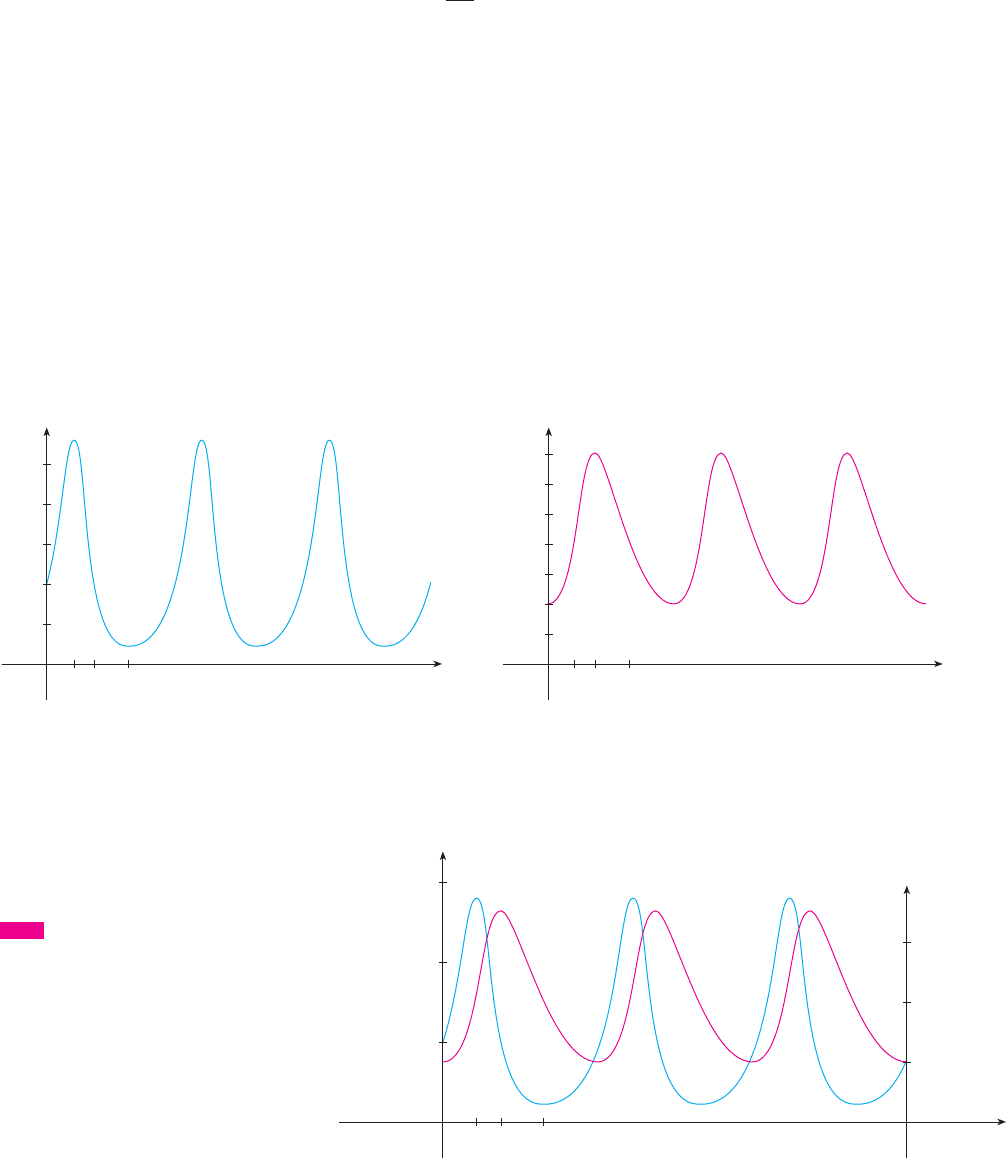
in the first differential equation, we get
Since , we conclude that R is increasing at and so we move counter-
clockwise around the phase trajectory.
We see that at there aren’t enough wolves to maintain a balance between the popu-
lations, so the rabbit population increases. That results in more wolves and eventually
there are so many wolves that the rabbits have a hard time avoiding them. So the number
of rabbits begins to decline (at , where we estimate that R reaches its maximum popu-
lation of about 2800). This means that at some later time the wolf population starts to
fall (at , where and ). But this benefits the rabbits, so their popula-
tion later starts to increase (at , where and ). As a consequence, the
wolf population eventually starts to increase as well. This happens when the populations
return to their initial values of and , and the entire cycle begins again.
(e) From the description in part (d) of how the rabbit and wolf populations rise and fall,
we can sketch the graphs of and . Suppose the points , , and in Figure 3
are reached at times , , and . Then we can sketch graphs of R and W as in Figure 4.
To make the graphs easier to compare, we draw the graphs on the same axes but with
different scales for R and W, as in Figure 5. Notice that the rabbits reach their maximum
populations about a quarter of a cycle before the wolves.
M
F I G U R E 5
Comparison of the rabbi
and wolf populations
0
t
R
t¡ t£
W
120
80
40
t™
2000
1000
R
W
Number
of
wolves
Number
of
rabbits
3000
t
0
t
W
140
t¡ t£
120
100
80
60
40
20
t™
0
t
R
2500
t¡ t£t™
2000
1500
1000
500
t
3
t
2
t
1
P
3
P
2
P
1
W!t"R!t"
W ! 40R ! 1000
R # 210W ! 80P
3
W # 140R ! 1000P
2
P
1
P
0
P
0
dR$dt % 0
dR
dt
! 0.08!1000" ! 0.001!1000"!40" ! 80 ! 40 ! 40
W ! 40
SECTION 10.6 PREDATOR-PREY SYSTEMS
|| ||
647
F I G U R E 4
Graphs of the rabbit and wolf
populations as functions of time
In Module 10.6 you can change the
coefficients in the Lotka-Volterra equations
and observe the resulting changes in the
phase trajectory and graphs of the rabbit
and wolf populations.
TE C
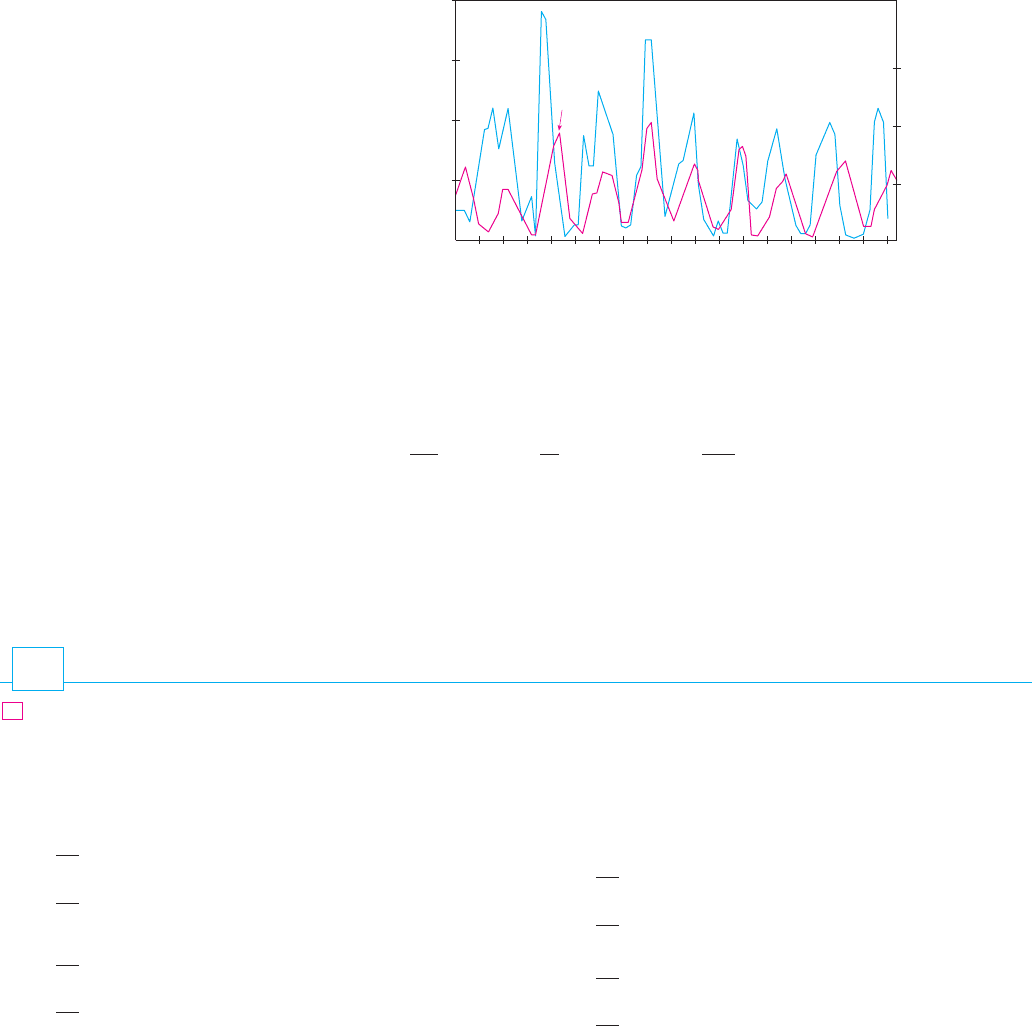
An important part of the modeling process, as we discussed in Section 1.2, is to inter-
pret our mathematical conclusions as real-world predictions and to test the predictions
against real data. The Hudson’s Bay Company, which started trading in animal furs in
Canada in 1670, has kept records that date back to the 1840s. Figure 6 shows graphs of the
number of pelts of the snowshoe hare and its predator, the Canada lynx, traded by the com-
pany over a 90-year period. You can see that the coupled oscillations in the hare and lynx
populations predicted by the Lotka-Volterra model do actually occur and the period of
these cycles is roughly 10 years.
Although the relatively simple Lotka-Volterra model has had some success in explain-
ing and predicting coupled populations, more sophisticated models have also been pro-
posed. One way to modify the Lotka-Volterra equations is to assume that, in the absence
of predators, the prey grow according to a logistic model with carrying capacity K. Then
the Lotka-Volterra equations (1) are replaced by the system of differential equations
This model is investigated in Exercises 9 and 10.
Models have also been proposed to describe and predict population levels of two
species that compete for the same resources or cooperate for mutual benefit. Such models
are explored in Exercise 2.
dW
dt
! !rW " bRW
dR
dt
! kR
'
1 !
R
K
(
! aRW
0
1850
9
6
3
160
120
80
40
hare
lynx
Thousands
of lynx
Thousands
of hares
1875 1900 1925
F I G U R E 6
Relative abundance of hare and lynx
from Hudson’s Bay Company records
648
|| ||
CHAPTER 10 DIFFERENTIAL EQUATIONS
2. Each system of differential equations is a model for two
species that either compete for the same resources or cooperate
for mutual benefit (flowering plants and insect pollinators, for
instance). Decide whether each system describes competition
or cooperation and explain why it is a reasonable model. (Ask
yourself what effect an increase in one species has on the
growth rate of the other.)
(a)
(b)
dy
dt
! 0.2y ! 0.00008y
2
! 0.0002xy
dx
dt
! 0.15x ! 0.0002x
2
! 0.0006xy
dy
dt
! 0.08x " 0.00004xy
dx
dt
! 0.12x ! 0.0006x
2
" 0.00001xy
For each predator-prey system, determine which of the vari-
ables, or , represents the prey population and which repre-
sents the predator population. Is the growth of the prey
restricted just by the predators or by other factors as well? Do
the predators feed only on the prey or do they have additional
food sources? Explain.
(a)
(b)
dy
dt
! !0.015y " 0.00008xy
dx
dt
! 0.2x ! 0.0002x
2
! 0.006xy
dy
dt
! 0.1y ! 0.005xy
dx
dt
! !0.05x " 0.0001xy
yx
1.
E X E R C I S E S
10.6
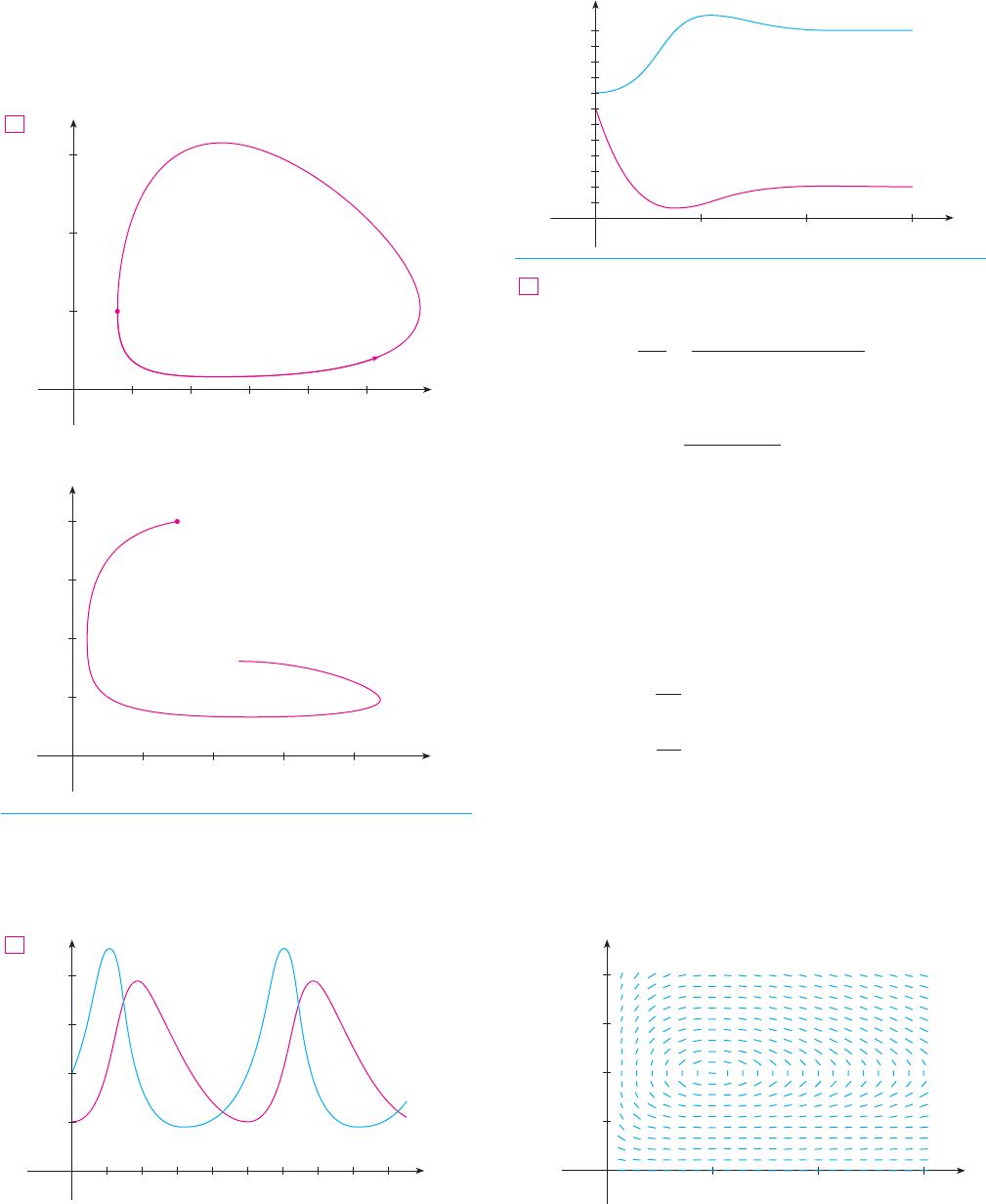
6.
In Example 1(b) we showed that the rabbit and wolf popula-
tions satisfy the differential equation
By solving this separable differential equation, show that
where is a constant.
It is impossible to solve this equation for as an explicit
function of (or vice versa). If you have a computer algebra
system that graphs implicitly defined curves, use this equation
and your CAS to draw the solution curve that passes through
the point and compare with Figure 3.
8. Populations of aphids and ladybugs are modeled by the
equations
(a) Find the equilibrium solutions and explain their
significance.
(b) Find an expression for .
(c) The direction field for the differential equation in part (b)
is shown. Use it to sketch a phase portrait. What do the
phase trajectories have in common?
0
A
L
200
5000 10000 15000
400
100
300
dL$dA
dL
dt
! !0.5L " 0.0001AL
dA
dt
! 2A ! 0.01AL
!1000, 40"
R
W
C
R
0.02
W
0.08
e
0.00002R
e
0.001W
! C
dW
dR
!
!0.02W " 0.00002RW
0.08R ! 0.001RW
7.
0
t
y
800
5
400
species 1
species 2
10 15
1200
600
200
1000
3– 4 A phase trajectory is shown for populations of rabbits
and foxes .
(a) Describe how each population changes as time goes by.
(b) Use your description to make a rough sketch of the graphs of
R and F as functions of time.
4.
5–6 Graphs of populations of two species are shown. Use them
to sketch the corresponding phase trajectory.
species 1
species 2
0
t
y
200
150
1
100
50
5.
t=0
0
R
F
400
160
120
80
800 1200 1600
40
t=0
0
R
F
400
300
200
100
800 1200 1600 2000
3.
!F"
!R"
SECTION 10.6 PREDATOR-PREY SYSTEMS
|| ||
649
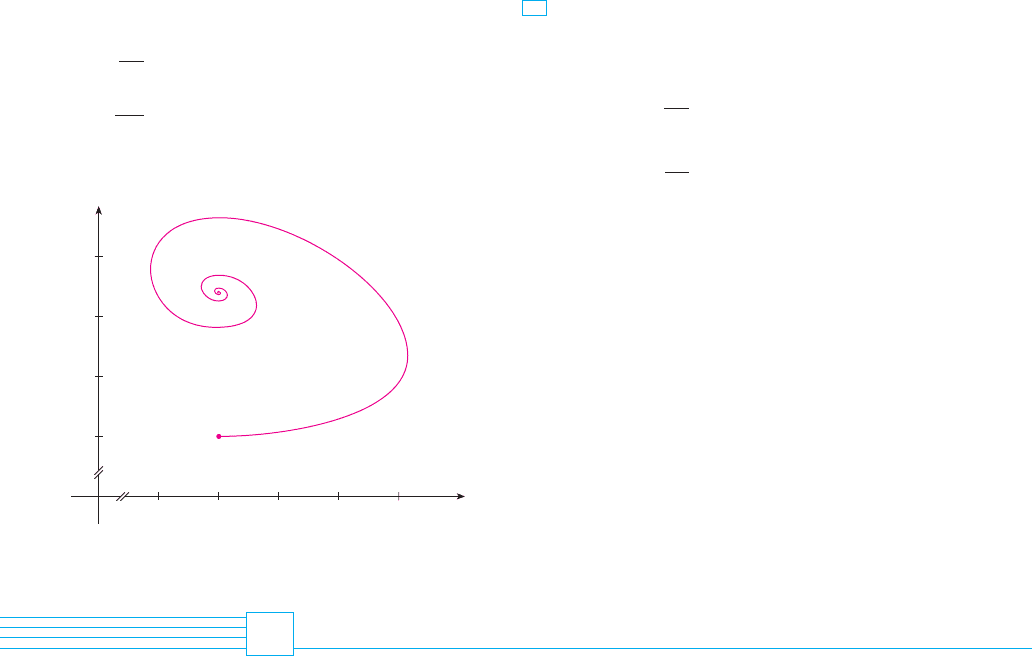
(b) Find all the equilibrium solutions and explain their
significance.
(c) The figure shows the phase trajectory that starts at the
point . Describe what eventually happens to the
rabbit and wolf populations.
(d) Sketch graphs of the rabbit and wolf populations as func-
tions of time.
10. In Exercise 8 we modeled populations of aphids and ladybugs
with a Lotka-Volterra system. Suppose we modify those equa-
tions as follows:
(a) In the absence of ladybugs, what does the model predict
about the aphids?
(b) Find the equilibrium solutions.
(c) Find an expression for .
(d) Use a computer algebra system to draw a direction field
for the differential equation in part (c). Then use the
direction field to sketch a phase portrait. What do the
phase trajectories have in common?
(e) Suppose that at time there are 1000 aphids and
200 ladybugs. Draw the corresponding phase trajectory
and use it to describe how both populations change.
(f) Use part (e) to make rough sketches of the aphid and
ladybug populations as functions of . How are the graphs
related to each other?
t
t ! 0
dL$dA
dL
dt
! !0.5L " 0.0001AL
dA
dt
! 2A!1 ! 0.0001A" ! 0.01AL
CAS
!1000, 40"
(d) Suppose that at time there are 1000 aphids and
200 ladybugs. Draw the corresponding phase trajectory
and use it to describe how both populations change.
(e) Use part (d) to make rough sketches of the aphid and
ladybug populations as functions of . How are the graphs
related to each other?
9. In Example 1 we used Lotka-Volterra equations to model
populations of rabbits and wolves. Let’s modify those
equations as follows:
(a) According to these equations, what happens to the rabbit
population in the absence of wolves?
R
W
800
70
60
50
1000 1200 1400
40
1600
dW
dt
! !0.02W " 0.00002RW
dR
dt
! 0.08R!1 ! 0.0002R" ! 0.001RW
t
t ! 0
650
|| ||
CHAPTER 10 DIFFERENTIAL EQUATIONS
REVIEW
C O N C E P T C H E C K
10
7. (a) Write a differential equation that expresses the law of
natural growth. What does it say in terms of relative
growth rate?
(b) Under what circumstances is this an appropriate model for
population growth?
(c) What are the solutions of this equation?
8. (a) Write the logistic equation.
(b) Under what circumstances is this an appropriate model for
population growth?
9. (a) Write Lotka-Volterra equations to model populations of
food fish and sharks .
(b) What do these equations say about each population in the
absence of the other?
!S"!F"
1. (a) What is a differential equation?
(b) What is the order of a differential equation?
(c) What is an initial condition?
2. What can you say about the solutions of the equation
just by looking at the differential equation?
3. What is a direction field for the differential equation
?
4. Explain how Euler’s method works.
5. What is a separable differential equation? How do you solve it?
6. What is a first-order linear differential equation? How do you
solve it?
y$ ! F!x, y"
y$ ! x
2
" y
2

Determine whether the statement is true or false. If it is true, explain why.
If it is false, explain why or give an example that disproves the statement.
1. All solutions of the differential equation are
decreasing functions.
2. The function is a solution of the differential
equation .
3. The equation is separable.
4. The equation is separable.y$ ! 3y ! 2x " 6xy ! 1
y$ ! x " y
x
2
y$ " xy ! 1
f !x" ! !ln x"$x
y$ ! !1 ! y
4
5. The equation is linear.
6. The equation is linear.
7. If is the solution of the initial-value problem
then .lim
t
l
#
y ! 5
y!0" ! 1
dy
dt
! 2y
'
1 !
y
5
(
y
y$ " xy ! e
y
e
x
y$ ! y
T R U E - FA L S E Q U I Z
1. (a) A direction field for the differential equation
is shown. Sketch the graphs of the
solutions that satisfy the given initial conditions.
(i) (ii)
(iii) (iv)
(b) If the initial condition is , for what values of
is finite? What are the equilibrium solutions?
2. (a) Sketch a direction field for the differential equation
. Then use it to sketch the four solutions that
satisfy the initial conditions , ,
, and .
(b) Check your work in part (a) by solving the differential
equation explicitly. What type of curve is each solution
curve?
3. (a) A direction field for the differential equation
is shown. Sketch the solution of the initial-value problem
Use your graph to estimate the value of .y!0.3"
y!0" ! 1y$ ! x
2
! y
2
y$ ! x
2
! y
2
y!!2" ! 1y!2" ! 1
y!0" ! !1y!0" ! 1
y$ ! x$y
0
x
y
1 2
2
4
6
lim
t
l
#
y!t"c
y!0" ! c
y!0" ! 4.3y!0" ! 3
y!0" ! 1y!0" ! !0.3
y$ ! y!y ! 2"!y ! 4"
(b) Use Euler’s method with step size 0.1 to estimate
where is the solution of the initial-value problem in
part (a). Compare with your estimate from part (a).
(c) On what lines are the centers of the horizontal line
segments of the direction field in part (a) located? What
happens when a solution curve crosses these lines?
4. (a) Use Euler’s method with step size 0.2 to estimate ,
where is the solution of the initial-value problem
(b) Repeat part (a) with step size 0.1.
(c) Find the exact solution of the differential equation and
compare the value at 0.4 with the approximations in
parts (a) and (b).
5– 8 Solve the differential equation.
5. 6.
7. 8.
x
2
y$ ! y ! 2x
3
e
!1$x
2ye
y
2
y$ ! 2x " 3
s
x
dx
dt
! 1 ! t " x ! txy$ ! xe
!sin x
! y cos x
y!0" ! 1y$ ! 2xy
2
y!x"
y!0.4"
y!x"
y!0.3"
0
x
y
1 2_1_2
1
2
_1
_2
3_3
3
_3
E X E R C I S E S
CHAPTER 10 REVIEW
|| ||
651
